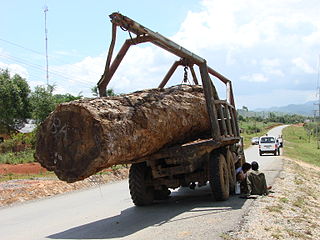
Dacrydium cupressinum, commonly known as rimu, is a large evergreen coniferous tree endemic to the forests of New Zealand. It is a member of the southern conifer group, the podocarps.

Agathis australis, commonly known by its Māori name kauri, is a coniferous tree in the family Araucariaceae, found north of 38°S in the northern regions of New Zealand's North Island.

Pinus radiata, the Monterey pine, insignis pine or radiata pine, is a species of pine native to the Central Coast of California and Mexico. It is an evergreen conifer in the family Pinaceae.
Tangiwai is a 2,696.66 km2 (1,041.19 sq mi) census area and a small rural community in the Ruapehu District of the Manawatū-Whanganui region of New Zealand's North Island. It is located east of Ohakune and Rangataua and west of Waiouru on State Highway 49. In 2018 37.5% of the area's 1,281 residents worked in agriculture, forestry and fishing and 7.1% in manufacturing.
Northland College is a small co-educational secondary school in Kaikohe.

Kauri gum is resin from kauri trees, which historically had several important industrial uses. It can also be used to make crafts such as jewellery. Kauri forests once covered much of the North Island of New Zealand, before climate change caused the forests to retreat, causing several areas to revert to sand dunes, scrubs, and swamps. Even afterwards, ancient kauri fields and the remaining forests continued to provide a source for the gum. Between 1820 and 1900, over 90% of Kauri forests were logged or burnt by Europeans.

Woodchipping is the act and industry of chipping wood for pulp. Timber is converted to woodchips and sold, primarily, for paper manufacture. In Australia, woodchips are produced by clearcutting or thinning of native forests or plantations. In other parts of the world, forestry practices such as short rotation coppice are the usual methods adopted.
The Maruia Declaration was a public petition calling for the immediate phasing out of the logging of virgin native forest in New Zealand.
The Russian forestry industry is a set of Russian industries related to wood harvesting and processing. As one of the oldest sectors in the country's economy, Russia's timber industry continues to bring in about $20 billion per year. Russia has more than a fifth of the world's forests, making it the largest forest country in the world. According to data for 2015, the total forest area has exceeded 885 million hectares, representing 45% of the total area of the country. The stock of wood in the area was 82 billion cubic meters.

New Zealand's former Government Buildings sit on the Government Buildings Historic Reserve, on Lambton Quay in central Wellington. The buildings were completed in 1876 on land reclaimed from Wellington Harbour to house the young New Zealand Government and its public service.

Deforestation in Laos is a major environmental concern, with Laos losing forest area to legal and illegal logging.

Woodchipping in New Zealand is one of the sectors of the forestry industry and it attracted controversy in the 1990s when native trees were used as a source for the chipping.

In New Zealand, agriculture is the largest sector of the tradable economy. The country exported NZ$46.4 billion worth of agricultural products in the 12 months to June 2019, 79.6% of the country's total exported goods. The agriculture, forestry and fisheries sector directly contributed $12.653 billion of the national GDP in the 12 months to September 2020, and employed 143,000 people, 5.9% of New Zealand's workforce, as of the 2018 census.

Swamp kauri, sometimes marketed as "ancient kauri", are prehistoric kauri trees, buried and preserved in peat up to 50,000 years ago in New Zealand's North Island. Buried under a peat swamp by an unexplained act of nature at the end of the last Ice Age, the trees have survived the centuries underground, sealed in a chemically balanced environment that has preserved the timber in almost perfect condition.
Deforestation in New Zealand has been a contentious environmental issue in the past, but native forests now have legal protection, and are not allowed to be tampered with by humans.

Pureora Forest Park is a 760-square-kilometre (290 sq mi) protected area in the North Island of New Zealand. Within its rich rainforest are an abundance of 1,000-year-old podocarp trees. It is "recognised as one of the finest rain forests in the world". Established in 1978, after a series of protests and tree sittings, the park is one of the largest intact tracts of native forest in the North Island and has high conservation value due to the variety of plant life and animal habitats. New Zealand's largest totara tree is located nearby on private land.

The North Island temperate forests, also known as the Northland temperate forests, is a temperate broadleaf and mixed forests ecoregion on New Zealand’s North Island.

Forests cover about 50% of the territory of Estonia, or around 2 million hectares, and so make out an important and dominating landscape type in the country. National law and policies recognize that forests are a natural and ecological resource, and the importance of forests is to be considered from an economic, social, ecological and cultural aspect.
The wood industry or timber industry is the industry concerned with forestry, logging, timber trade, and the production of primary forest products and wood products and secondary products like wood pulp for the pulp and paper industry. Some of the largest producers are also among the biggest owners of timberland. The wood industry has historically been and continues to be an important sector in many economies.

Ellis and Burnand was a New Zealand sawmilling and timber retailing company, formed by businessman John William Ellis and engineer Harry Burnand in 1891.

















